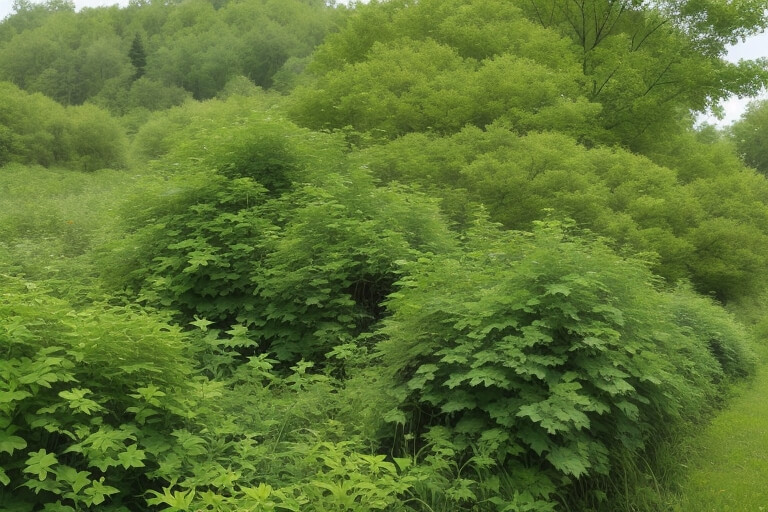Invasive plants, categorized as non-native species that have successfully established themselves in new environments, represent a formidable menace that extends far beyond their unassuming appearances. These ecological invaders possess a remarkable ability to adapt and proliferate, fundamentally altering the landscapes they invade. Their impact, though often underestimated, is nothing short of transformative, and the consequences are far-reaching.
 The first step in comprehending the menace of invasive plants lies in our ability to accurately identify them. These botanical intruders have a knack for disguising themselves amidst native flora, making their early detection all the more crucial. Among the roster of notorious culprits, Japanese Knotweed stands as a prominent example. Its robust, bamboo-like stems and heart-shaped leaves may not immediately raise alarm, but beneath the surface, it launches a relentless underground campaign through a network of invasive rhizomes, rendering it a formidable adversary in any landscape.
The first step in comprehending the menace of invasive plants lies in our ability to accurately identify them. These botanical intruders have a knack for disguising themselves amidst native flora, making their early detection all the more crucial. Among the roster of notorious culprits, Japanese Knotweed stands as a prominent example. Its robust, bamboo-like stems and heart-shaped leaves may not immediately raise alarm, but beneath the surface, it launches a relentless underground campaign through a network of invasive rhizomes, rendering it a formidable adversary in any landscape.
Purple Loosestrife, with its striking spikes adorned by purple-pink blossoms, may appear enchanting, yet it conceals a detrimental agenda. Thriving in wetlands, this invasive plant displaces native wetland flora, disrupting the delicate balance of these ecosystems. Similarly, Common Buckthorn, characterized by its dark, glossy leaves and small, black berries, quietly infiltrates woodlands and hedgerows, stealthily outcompeting native vegetation and reshaping the composition of these ecosystems.
Garlic Mustard, with its innocuous appearance and pungent garlic-like scent when crushed, betrays its insidious nature in woodlands. This invasive species quickly establishes dominance, jeopardizing the survival of native woodland plants.
The ecological impact of invasive plants, once they establish a foothold, is both profound and insidious. Competitive exclusion, a phenomenon where invasive plants outcompete native species for crucial resources like water, sunlight, and nutrients, weakens the native plants and can even lead to their decline or eventual extinction. Some invasive plants possess the unsettling ability to alter the chemical composition of the soil, rendering it less hospitable to native flora, thereby further facilitating their own dominance. The intricate relationships between native plants and their pollinators are also disrupted, as invasive species may not provide the same benefits to local pollinators, potentially compromising the reproductive success of both plants and fauna. Invasive plants can create dense, highly flammable vegetation, elevating the risk of wildfires that can ravage natural ecosystems and exacerbate the menace they already pose.
Strategies for Effective Control
Manual Removal, as a hands-on approach, is most effective for small-scale infestations. This method involves physically removing invasive plants by hand, employing techniques such as hand-pulling, cutting, or digging them out. While this approach can be successful, it may not be practical for larger infestations or species with extensive root systems. Nonetheless, it remains a valuable tool in the arsenal against invasives, especially in areas where a delicate touch is required to protect native flora.
 Herbicides, chemical compounds designed to kill or inhibit plant growth, can be used as a targeted strategy against invasive plants. Selective herbicides are specifically formulated to target certain species while minimizing harm to native vegetation. The application of herbicides necessitates strict adherence to guidelines and safety precautions to prevent unintended harm to the environment. Proper training and knowledge of the specific invasive species in question are crucial for successful herbicide application.
Herbicides, chemical compounds designed to kill or inhibit plant growth, can be used as a targeted strategy against invasive plants. Selective herbicides are specifically formulated to target certain species while minimizing harm to native vegetation. The application of herbicides necessitates strict adherence to guidelines and safety precautions to prevent unintended harm to the environment. Proper training and knowledge of the specific invasive species in question are crucial for successful herbicide application.
Biological Control represents a more ecologically friendly and long-term approach to managing invasive plants. This method involves introducing natural predators, herbivores, or diseases that specifically target invasive plants. These biocontrol agents help to curb the growth and spread of invasives while minimizing harm to native species. The implementation of biological control requires extensive research and ongoing monitoring to ensure that it does not inadvertently disrupt the balance of the ecosystem or harm non-target species.
Prevention, often heralded as the most cost-effective strategy, centers on stopping invasive plants before they gain a foothold in new areas. This proactive approach involves early detection, continuous monitoring, and stringent regulations regarding the introduction and sale of invasive plant species. By preventing their establishment in the first place, we can significantly reduce the economic and ecological costs associated with managing established invasive populations.
Effective control of invasive plants necessitates a nuanced approach that considers the scale of infestation, the specific species involved, and the ecological context of the affected area. Combining manual removal for localized efforts, judicious herbicide application for targeted control, biological control for long-term management, and prevention measures to thwart new introductions creates a comprehensive strategy for combating invasive plants.
The Road Ahead
The broader populace must be informed about the detrimental impact of invasive plants, their modes of spread, and the consequences of inaction. Public engagement plays a pivotal role in early detection and reporting of invasive species, crucial components of successful management and containment. Community involvement in invasive plant removal efforts, whether in urban parks or natural reserves, can significantly enhance our capacity to combat these intruders.
Scientific research is the cornerstone upon which effective control strategies are built. Ongoing studies are necessary to better understand the biology, ecology, and behavior of invasive plants, enabling us to refine our management tactics. Research into the development of new, environmentally responsible control methods, such as biocontrol agents, remains imperative.
Land managers bear the responsibility of implementing control measures on a broader scale. They must adopt adaptive management practices that consider the unique characteristics of the ecosystems they oversee. Collaboration among land managers across jurisdictions and regions is essential to prevent the spread of invasive plants beyond their current boundaries.
Legislation and policy frameworks play a crucial role in invasive plant management. Governments and regulatory bodies must enact and enforce legislation that restricts the introduction and sale of invasive plant species. These regulations should be backed by robust enforcement mechanisms and supported by public education campaigns.
Invasive plant management strategies must be integrated with broader conservation efforts. Preserving and restoring native habitats can enhance the resilience of ecosystems against invasive species, as healthy ecosystems are less susceptible to invasion.